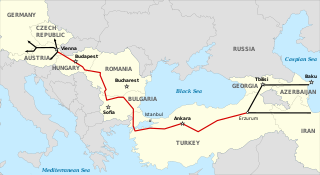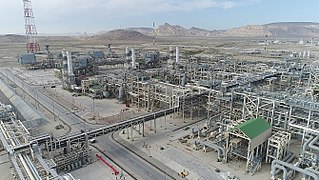| South East Europe Pipeline (proposal) | |
|---|---|
| Location | |
| Country | Turkey, Bulgaria, Romania, Hungary, Austria |
| General direction | east–west |
| From | Eastern Turkey |
| To | Baumgarten an der March, Austria |
| General information | |
| Type | natural gas |
| Partners | BP |
| Technical information | |
| Length | 800 km (500 mi) |
The South East Europe Pipeline was a proposal for a natural gas pipeline from eastern Turkey to Baumgarten an der March in Austria. It was seen as an option for diversification of natural gas potential delivery routes for Europe from Azerbaijan. The pipeline would allow Azerbaijan to supply Europe with 10 billion cubic metres (350 billion cubic feet) of natural gas a year. [1] The main source of the gas would be Shah Deniz gas field when its second stage comes online. [2]
The pipeline was proposed by BP on 24 September 2011 as an alternative to the existing Southern Gas Corridor projects, including the Nabucco pipeline, Trans Adriatic Pipeline, and Interconnector Turkey–Greece–Italy. [2] [3] [4] The pipeline was to use existing pipelines, but also needed 800–1,000 kilometres (500–620 mi) (by other sources 1,300 kilometres (810 mi)) of new pipeline to be laid in different countries. [2] [3] The total route is about 3,800 kilometres (2,400 mi). [4]
On 28 June 2012 the BP-led Shah Deniz consortium announced it will choose between Nabucco West and Trans Adriatic Pipeline as an export option, and accordingly development of the South East Europe Pipeline project will cease. [5]
The State Oil Company of the Republic of Azerbaijan, largely known by its abbreviation SOCAR, is a fully state-owned national oil and gas company headquartered in Baku, Azerbaijan. The company produces oil and natural gas from onshore and offshore fields in the Azerbaijani segment of the Caspian Sea. It operates the country's only oil refinery, one gas processing plant and runs several oil and gas export pipelines throughout the country. It owns fuel filling station networks under the SOCAR brand in Azerbaijan, Turkey, Georgia, Ukraine, Romania, Switzerland, and Austria.

The Nabucco pipeline was a failed natural gas pipeline project from Erzurum, Turkey to Baumgarten an der March, Austria to diversify natural gas suppliers and delivery routes for Europe. The pipeline was to lessen European dependence on Russian energy. The project was backed by several European Union states and the United States and was seen as rival to the Gazprom-Eni South Stream pipeline project. The main supplier was to be Iraq with potential supplies from Azerbaijan, Turkmenistan, and Egypt.

Shah Deniz gas field is the largest natural gas field in Azerbaijan. It is situated in the South Caspian Sea, off the coast of Azerbaijan, approximately 70 kilometres (43 mi) southeast of Baku, at a depth of 600 metres (2,000 ft). The field covers approximately 860 square kilometres (330 sq mi). Stretching out over 140 square kilometres, the reservoir is similar in size and shape to Manhattan Island.
Azeri–Chirag–Gunashli or Azeri–Chirag–Deepwater Gunashli is a complex of oil fields in the Caspian Sea, about 120 kilometres (75 mi) off the coast of Azerbaijan. It consists of the Azeri and Chirag oil fields, and the deepwater portion of the Gunashli oil field. An overall estimate of the area of the development is 432.4 square kilometres (167.0 sq mi). It is developed by the Azerbaijan International Operating Company, a consortium of international oil companies, and operated by BP on behalf of the consortium. The ACG fields have estimated recoverable reserves of about 5 to 6 billion barrels of petroleum. Peak oil production of 885,000 barrels per day (140,700 m3/d) was reached in 2010. However by the first quarter of 2024 production had fallen to 339,000 barrels per day (53,900 m3/d), or approximately one-third of peak value, as the development continued terminal decline. As of 2021, ACG oil accounted for 95% of all Azerbaijani oil exports.

The South Caucasus Pipeline is a natural gas pipeline from the Shah Deniz gas field in the Azerbaijan sector of the Caspian Sea to Turkey. It runs parallel to the Baku–Tbilisi–Ceyhan pipeline (oil).

The Trans-Caspian Gas Pipeline is a proposed subsea pipeline between Türkmenbaşy in Turkmenistan, and Baku in Azerbaijan. According to some proposals it would also include a connection between the Tengiz Field in Kazakhstan, the Sangachal Terminal in Baku, and Türkmenbaşy. The Trans-Caspian Gas Pipeline project would transport natural gas from Turkmenistan and Kazakhstan to European Union member countries, circumventing both Russia and Iran. It would do this by feeding the Southern Gas Corridor. This project attracts significant interest since it would connect vast Turkmen gas resources to major consumers Turkey and Europe.
White Stream is a proposed pipeline project to transport natural gas from the Caspian region to Romania and Ukraine with further supplies to Central Europe.

The Trans Adriatic Pipeline is a natural gas pipeline operational since 2020, running from Greece through Albania and the Adriatic Sea to Italy. It is the final section of the Southern Gas Corridor originating in Azerbaijan. As of 2022, capacity is 10 bcm per year.

The Republic of Azerbaijan and the European Union (EU) have maintained a positive relationship through the years and have become more closely linked since 1991. Azerbaijan is currently part of the European Neighborhood Policy, the Eastern Partnership and the Council of Europe. The EU is the largest foreign grant donor to and investor in Azerbaijan, both in the government sector and civil society, making available over 600 million EURO of bilateral EU assistance since 1992.

The Sangachal Terminal is an industrial complex consisting of a natural gas processing plant and oil production plant, located on the coast of the Caspian Sea 45 kilometres (28 mi) south of Baku, Azerbaijan.
As of 2017, Azerbaijan produced a range of metals and industrial minerals, including aluminum, bentonite, copper, gold, iodine, limestone, silver and steel.

The Southern Gas Corridor is an initiative of the European Commission for a natural gas supply route from Caspian and Middle Eastern regions to Europe, proposed in 2008. The goal of the Southern Gas Corridor is to reduce Europe's dependency on Russian gas and add diverse sources of energy supply. The route from Azerbaijan to Europe consists of the South Caucasus Pipeline, the Trans-Anatolian Pipeline, and the Trans Adriatic Pipeline. The total investment of this route is estimated US$35 billion. The main supply source would be the Shah Deniz gas field, located in the Caspian Sea.
The Mozdok–Makhachkala–Kazi Magomed pipeline is a natural gas pipeline from Mozdok in North Ossetia through Chechnya and Dagestan to Azerbaijan. The Azerbaijani section is also known as the Kazi Magomed–Novo Filya or Baku–Novo Filya, and it connects Baku with the Novo Filya gas metering utility on the Russian side of the Azerbaijan-Russia border. The pipeline will be used for transportation of Azerbaijani gas to Russia starting from 1 January 2010.
Azeri is an offshore oil field in the Caspian Sea, located 100 km (62 mi) east of Baku, Azerbaijan and is a part of the larger Azeri-Chirag-Guneshli (ACG) project. The Azeri field includes Central Azeri, West Azeri, East Azeri production platforms compression and water injection platform (C&WP). The field was discovered in 1988, and originally it was named after 26 Baku Commissars.
The Azerbaijan–Georgia–Romania Interconnector (AGRI) is a proposed project to transport Azerbaijani natural gas to Romania and further to Central Europe. Natural gas would be transported by the pipeline from Sangachal Terminal in Azerbaijan to the Kulevi Terminal at the Black Sea coast of Georgia. In Kulevi, the liquefied natural gas export terminal would be built. Liquefied natural gas will be transported by LNG tankers to the Constanța terminal in Romania. After regasification natural gas will be delivered through the existing gas grid to Romania and other European countries. Alternative to the transportation of liquefied natural gas is transportation of compressed natural gas.
Umid gas field is the second largest natural gas field in Azerbaijan. It is situated in the South Caspian Sea, off the coast of Azerbaijan, approximately 75 kilometres (47 mi) southeast of Baku, at a depth of 170 metres (560 ft). In translation from Azerbaijani, Umid means Hope.

The Absheron gas field is an offshore natural gas field in the Caspian Sea. The field is located 100 kilometres (62 mi) southeast of Baku and 25 kilometres (16 mi) northeast of the Shah Deniz gas field. It covers approximately 270 square kilometres (100 sq mi).

The Trans-Anatolian Natural Gas Pipeline is a natural gas pipeline in Turkey. It is the central part of the Southern Gas Corridor, which connects the giant Shah Deniz gas field in Azerbaijan to Europe through the South Caucasus Pipeline and the Trans Adriatic Pipeline. The pipeline has a strategic importance for both Azerbaijan and Turkey. It allows the first Azerbaijani gas exports to Europe, beyond Turkey. It also strengthens the role of Turkey as a regional energy hub.
Gas flows from Turkey to Greece through a pipeline which is almost 300 km long. It is an incomplete transportation project that was proposed in the framework of the Southern Gas Corridor. It was proposed for the transportation of natural gas from Azerbaijan's Shah Deniz gas field Phase II to markets in Europe via Greece and Italy. The Turkey–Greece pipeline was completed in 2007 while the Greece–Italy pipeline was not built, due to the competing Trans Adriatic Pipeline.

Azerbaijan is one of the birthplaces of the oil industry and its history is linked to the fortunes of petroleum, with pipelines used from the late 19th century. The total length of the main pipeline in Azerbaijan is 4,600 kilometres (2,900 mi)